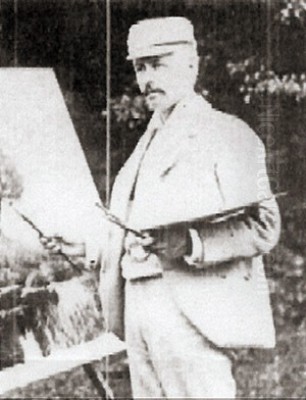
Edward Wilkins Waite (1854-1924) stands as a significant figure in the tradition of British landscape painting during the late Victorian and Edwardian periods. A dedicated oil painter, he carved a niche for himself through his evocative and detailed portrayals of the rural scenery of Southern England, particularly the counties of Surrey, Sussex, and Berkshire. His work captures a sense of pastoral tranquility and a deep appreciation for the enduring beauty of the English countryside, offering a valuable visual record of these areas before the widespread changes of the 20th century.
Waite's commitment to landscape art places him firmly within a long lineage of British artists drawn to the natural world, yet his specific focus and consistent style give his oeuvre a distinct identity. He operated during a time of artistic flux, with Impressionism making inroads and various realist schools flourishing, but Waite largely remained true to a more traditional, detailed approach, finding favour with audiences who appreciated skillful rendering and familiar, comforting scenes.
Early Life and Artistic Foundations
Born in Leatherhead, Surrey, in 1854, Edward Wilkins Waite entered a world seemingly predisposed towards the arts. His family environment was rich with artistic inclination. His grandfather, William Watkin Waite, was noted as a miniature and portrait painter. Furthermore, his father, the Reverend Edward Waite, was himself an accomplished watercolour artist, suggesting that young Edward was exposed to artistic practice and appreciation from an early age.
This familial artistic leaning extended to his siblings. Several of his brothers, including Charles Waite, Harold Waite, and Arthur Waite, also pursued artistic careers, creating a supportive, if potentially competitive, environment. Growing up in Surrey, the very landscape that would become his principal subject, undoubtedly played a crucial role in shaping his artistic vision. The gentle hills, wooded lanes, meandering rivers, and picturesque villages of his home county provided endless inspiration.
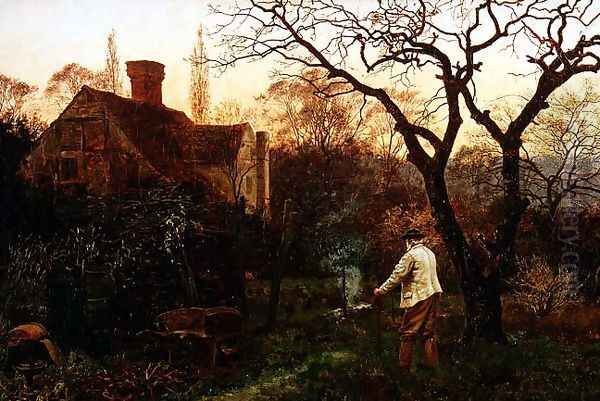
Formal art training supplemented his home environment. Waite is known to have attended the Farnham School of Art, an institution that would have provided him with foundational skills in drawing and painting. While records regarding extensive training at the Royal Academy Schools are less definitive, he certainly entered the orbit of the London art establishment, becoming a regular exhibitor at the prestigious Royal Academy summer exhibitions. This exposure was critical for any aspiring artist seeking recognition and patronage.
An interesting interlude in his early adulthood was a trip to Canada in 1874. He spent several months there, an experience that, while not extensively documented in terms of artistic output from the journey, likely broadened his horizons and perhaps offered a contrasting perspective to the familiar English landscapes he would predominantly paint upon his return. This journey marks a brief departure before he settled into his long career focused on the British rural scene.
Developing a Signature Style: Realism and Atmosphere
Edward Wilkins Waite's artistic style solidified into one characterized by detailed realism combined with a sensitive rendering of light and atmosphere. He worked primarily in oils, a medium that allowed for rich colour saturation and the careful building up of texture and detail. His approach was meticulous, paying close attention to the specific forms of trees, the rendering of foliage, the play of light on water, and the textures of brickwork and timber in rural buildings.
Unlike the burgeoning Impressionist movement, which focused on capturing fleeting moments and the effects of light with looser brushwork, Waite maintained a commitment to careful delineation and finish. His work aligns more closely with the established traditions of Victorian landscape painting, valuing accuracy and a certain picturesque quality. Artists like Benjamin Williams Leader or George Vicat Cole were achieving great popularity with similarly detailed and accessible views of the British landscape, representing a mainstream taste that Waite's work also appealed to.
However, Waite's paintings are more than mere topographical records. He possessed a keen ability to evoke mood and atmosphere, often linked to specific times of day or seasons. His depictions of autumnal scenes, with their golden light and mellow tones, are particularly noteworthy. He captured the hazy light of late afternoon, the cool shadows of evening, or the crisp air of a spring morning with considerable skill, imbuing his landscapes with a palpable sense of place and time.
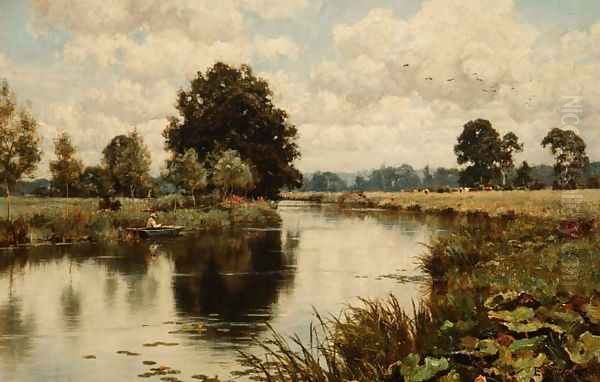
His brushwork, while detailed, was not overly laboured. There is a confidence and fluidity in his application of paint that keeps his scenes feeling natural rather than stiffly photographic. He excelled at depicting the lush greenery of the English summer, the intricate tracery of bare branches in winter, and the reflective qualities of rivers and ponds, demonstrating a thorough understanding of the natural elements he chose to represent.
The Heart of Surrey: A Lifelong Subject
Surrey remained the enduring heartland of Edward Wilkins Waite's artistic output. Having grown up there, he possessed an intimate knowledge of its lanes, woods, farms, and villages. He settled for a significant period in Brockham, a village near Dorking, and many of his most characteristic works depict this area. The River Mole, which flows through Brockham, features frequently in his canvases, its gentle course reflecting the surrounding trees and sky.
Waite was drawn to the vernacular architecture of the region – the timber-framed cottages, sturdy farmhouses, and ancient barns that dotted the landscape. Works featuring locations like Pondtail Farm or Noys End in Brockham exemplify this interest. These buildings are not just incidental elements but often form focal points, rendered with an appreciation for their history and integration into the rural setting. He painted specific, identifiable places, grounding his work in the reality of the Surrey countryside.
Titles such as Evening, Brockham (1890) or Autumn by Brockham capture his focus on this locality and his sensitivity to seasonal change. These works often depict quiet, pastoral scenes – perhaps cattle grazing near the river, a figure walking down a sun-dappled lane, or the stillness of a farmyard at the end of the day. They convey a sense of peace and stability, an idyllic vision of rural life that held strong appeal for urban audiences of the time.
Other Surrey locations also feature in his work, reflecting his exploration of the wider county. Paintings titled A Surrey Lane or Near Dorking suggest his broader engagement with the region's characteristic scenery. His deep connection to Surrey provided a consistent thread throughout his career, establishing him as one of the county's most dedicated visual chroniclers.
Expanding Horizons: Sussex and Berkshire
While Surrey was his primary muse, Waite's artistic explorations also extended into the neighbouring counties of Sussex and Berkshire. These areas offered variations on the southern English landscape theme, providing fresh subjects while allowing him to employ his established style and thematic interests. His depictions of Sussex, in particular, form a significant part of his later work.
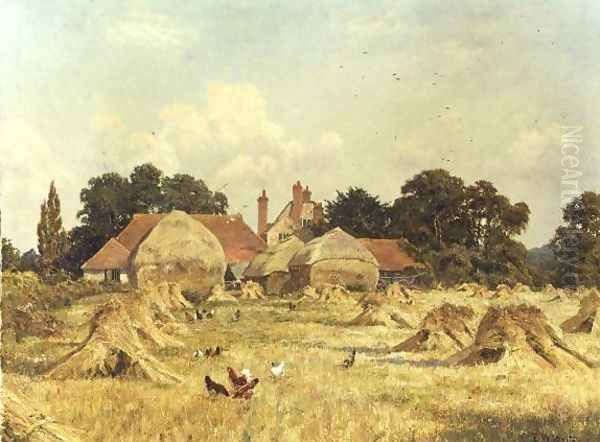
The village of Fittleworth in West Sussex became another favoured location. His painting A Golden Afternoon, The Grange, Fittleworth, Sussex, dated 1920, showcases his continued ability to capture the warm glow of sunlight on landscape and architecture late in his career. Fittleworth Mill, a picturesque subject attractive to many artists, also appeared in his work. These Sussex scenes often share the same qualities of tranquility and detailed observation found in his Surrey paintings.
His work in Berkshire is less frequently highlighted but forms part of his broader engagement with the landscapes of the Home Counties. The rolling chalk downs, river valleys, and charming villages of Berkshire would have offered subjects well-suited to his artistic temperament. Across these counties, his focus remained consistent: the beauty of the established rural landscape, the harmony between nature and traditional human settlement, and the atmospheric effects of light and season.
This geographical range demonstrates Waite's commitment to exploring the nuances of the southern English countryside. While rooted in Surrey, his willingness to paint scenes from Sussex and Berkshire broadened his repertoire and reinforced his reputation as a painter of quintessential English pastoral scenery. His approach remained consistent, applying his detailed, atmospheric style to the specific characteristics of each location.
Exhibition Career and Professional Recognition
Edward Wilkins Waite was an active participant in the London art world, primarily through regular submissions to major exhibitions. This was the principal way for artists of his era to gain visibility, attract patrons, and build a professional reputation. The Royal Academy of Arts summer exhibition was the most prestigious venue, and Waite exhibited there frequently over many years, demonstrating a consistent level of acceptance by the Academy's selection committees.
Beyond the Royal Academy, his works were also shown at other important London venues, including the Royal Society of British Artists (RBA) on Suffolk Street, the Grosvenor Gallery, and the New Gallery. These galleries catered to slightly different tastes and artist groups but were all significant platforms. Exhibiting across these venues indicates that Waite's work found a relatively broad audience within the mainstream art market of the time.
He also exhibited regionally, with works shown in important municipal galleries such as the Walker Art Gallery in Liverpool and the Manchester City Art Gallery. This provincial exposure further cemented his reputation outside the capital. The regularity of his exhibition activity suggests a steady output and a degree of commercial success, enabling him to sustain a career as a professional artist.
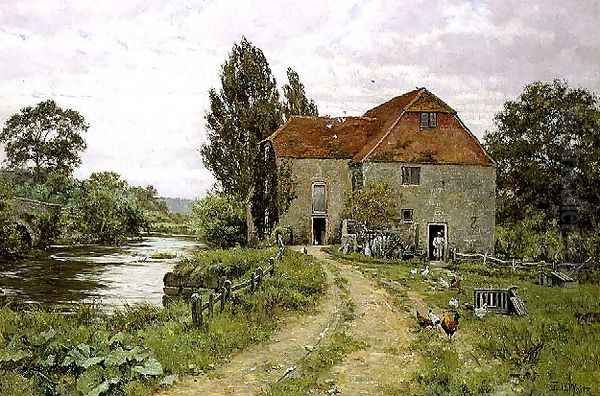
While not associated with avant-garde movements, Waite operated within a respected tradition. His contemporaries exhibiting similar landscape subjects at the RA and elsewhere included figures like Benjamin Williams Leader, whose dramatic views were immensely popular, and Alfred de Bréanski Sr., known for his highland and river scenes. Waite's quieter, more intimate focus on the southern counties offered a different flavour within this popular genre. His consistent presence in major exhibitions signifies his acceptance and standing within the established art circles of late Victorian and Edwardian Britain.
The Artist's Method: Records and Sketches
A fascinating insight into Edward Wilkins Waite's professional practice comes from the detailed record books he maintained. Starting around 1891, he began meticulously logging the paintings that passed through his studio. These records often included details such as the painting's title, its dimensions, the price asked or received, and sometimes notes about its exhibition history or destination (e.g., whether it was sold, to whom, or if it was submitted or re-submitted to a particular exhibition).
This systematic record-keeping reveals a methodical and business-like approach to his art career. It provides invaluable information for art historians today, helping to track the provenance of his works and understand the scope of his output. The inclusion of unsold works or those retained suggests it was a comprehensive inventory rather than just a sales ledger.
Complementing the finished oils and the record books was his use of sketches. Like many artists, Waite likely used preliminary sketches made outdoors to capture details of a scene or specific light effects. These sketches could then be worked up into larger compositions in the studio. Interestingly, evidence suggests his wife, Barbara Isabella Taylor, whom he married in 1891, sometimes assisted with or collaborated on these sketches.
These preparatory materials, often pencil drawings or watercolour studies, served as vital 'aide-memoires', allowing him to retain the freshness of an observed scene when translating it into a more elaborate oil painting. The existence of these sketches, alongside the detailed record books, paints a picture of Waite as a diligent and organized artist, carefully managing both the creative and practical aspects of his profession.
Waite in Context: Contemporaries and Influences
Placing Edward Wilkins Waite within the broader context of late 19th and early 20th-century British art helps to appreciate his specific contribution. He worked during a period of diverse artistic activity. The influence of the Pre-Raphaelites, such as John Everett Millais (though he later moved away from strict PRB style), was still felt, particularly in detailed rendering of nature. However, new movements were challenging traditional approaches.
French Impressionism had begun to influence British artists, leading to figures like Philip Wilson Steer exploring light and colour with much looser brushwork than Waite employed. Realism also took various forms. The Newlyn School, based in Cornwall and including artists like Stanhope Forbes and Walter Langley, focused on depicting the lives of fishing communities with an emphasis on natural light and social realism. Other artists like George Clausen and H. H. La Thangue applied realist principles, sometimes combined with Impressionist techniques, to agricultural scenes.
Waite's work stands somewhat apart from these trends. He did not adopt the bright palette and broken brushwork of Impressionism, nor the social commentary often found in Newlyn School paintings. His style remained closer to the established Victorian landscape tradition, perhaps finding kinship with the aforementioned B.W. Leader or George Vicat Cole in terms of subject matter and market appeal, though Waite's touch was often gentler and less dramatic. Watercolourists like Myles Birket Foster and Helen Allingham also specialized in idyllic rural scenes, though in a different medium.
While the provided information suggests a possible stylistic similarity to the German painter Walter Moras, particularly in atmospheric effects, there's no documented evidence of direct influence or collaboration between Waite and specific contemporaries. He appears to have pursued his own path, refining a personal style rooted in careful observation and a deep affection for the landscapes he knew best. His artistic lineage seems primarily derived from his family background and the prevailing tastes for picturesque, detailed landscape painting in Britain.
Later Life, Challenges, and Legacy
Waite's personal life saw significant changes and challenges in his later years. His marriage to Barbara Isabella Taylor in 1891, while potentially involving artistic collaboration on sketches, ultimately proved unhappy. The couple divorced in 1913, a relatively uncommon and likely difficult event at that time. Following the divorce, Waite moved residence, eventually settling in Abinger Hammer, another Surrey village nestled in the picturesque Tillingbourne valley.
His final years were marked by declining mental health. Records indicate that he was admitted to the Holloway Sanatorium, a well-known institution for mental health treatment near Virginia Water, on at least two occasions towards the end of his life. This suggests a period of considerable personal struggle. Edward Wilkins Waite passed away on Fulham Road in London in 1924.
Despite these later life difficulties, Waite left behind a substantial body of work that continues to be appreciated. His paintings offer enduring images of a tranquil English countryside, rendered with skill and sensitivity. They are sought after by collectors of traditional British art, appearing regularly at auction. His work is represented in various public collections, ensuring its accessibility for study and enjoyment.
A significant development for his legacy occurred in 2020 when a collection of his materials, including sketchbooks, loose sketches, and photographs, was donated to the Surrey History Centre. This archive provides an invaluable resource for researchers, offering deeper insights into his working methods, his life, and the specific locations he depicted. It helps to solidify his status as a key artistic figure associated with Surrey and the surrounding region.
Edward Wilkins Waite's contribution lies in his dedicated and lifelong portrayal of the southern English landscape. He captured a specific vision of rural England, one characterized by gentle beauty, harmony, and a deep connection to place. While not an innovator in the mould of the Impressionists or Post-Impressionists, he excelled within his chosen tradition, creating a body of work that remains visually appealing and historically significant as a record of the countryside he loved. His paintings continue to resonate with those who appreciate skillful representation and the enduring allure of the pastoral scene.